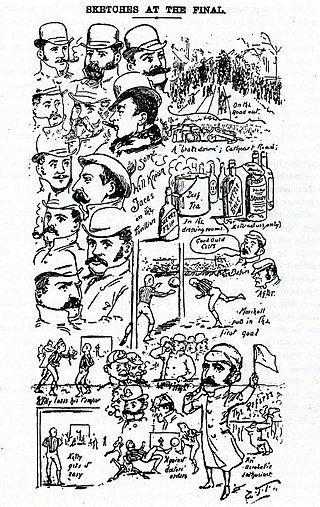Related Research Articles

Arthurlie Football Club are a Scottish football club from Barrhead, East Renfrewshire. Based at Dunterlie Park, they play in the West of Scotland Football League. The club played in the Scottish Football League in two spells, 1901 to 1915 and 1923 to 1929. They have won the Scottish Junior Cup twice, in 1937 and 1998.
Port Glasgow Athletic was a football club based in Port Glasgow, Scotland. The club was formed in 1878 and originally named Broadfield before changing their name in 1881. They played in the Scottish Football League between 1893 and 1911, and were based at Clune Park.
The Scottish Football Alliance was a football league football structure set up in Scotland in competition with the Scottish Football League. Its success in the early years of professional football in both England and Scotland made Alliance the basis for a second division in both countries. The alliance attracted a number of Junior clubs to the League system to guarantee its longevity for years to come.
Cowlairs Football Club was a 19th-century football club from the Cowlairs area of Glasgow in Scotland. The club were one of the founder members of the Scottish Football League in 1890, and played at Springvale Park during their time in the league.
The 1925–26 Scottish Cup was the 48th staging of Scotland's most prestigious football knockout competition. The tournament began on 23 January 1926 and ended on 10 April 1926. The cup was won by St Mirren, who defeated the previous years cup winners Celtic 2–0 in the final.
Dundee Wanderers Football Club was a football club based in Dundee, Scotland. They were formed in 1894 as a result of a merger between two local clubs, Wanderers and Strathmore. The club was briefly a member of the Scottish Football League (SFL), playing in Division Two during the 1894–95 season, but after finishing second from bottom of the league they failed re-election. In December 1894 the suffered an all-time record SFL defeat, losing 15–1 to Airdrieonians. Their home ground was Clepington Park.
Thistle Football Club was a 19th-century football club based in Glasgow. The club was briefly a member of the Scottish Football League Division Two, and has been described as the most insignificant and least successful to have entered the league. They played at Braehead Park during their Scottish League season.

The 1882–83 Scottish Cup – officially the Scottish Football Association Challenge Cup – was the tenth season of Scotland's most prestigious football knockout competition. Dumbarton won the cup for the first, and so far only, time when they beat Vale of Leven 2–1 in a replayed final.
The 1883–84 Scottish Cup was the 11th season of Scotland's most prestigious football knockout competition. Queen's Park won the competition for the seventh time after Vale of Leven could not field a team on the date fixed for the final due to player illness.
The 1884–85 Scottish Cup was the 12th season of Scotland's most prestigious football knockout competition. Renton won the competition for the first tie after they defeated Vale of Leven in a replayed final.
The 1885–86 Scottish Cup was the 13th season of Scotland's most prestigious football knockout competition. Queen's Park won the competition for the eighth time after they beat defending champions Renton 3–1 in the final.
The 1886–87 Scottish Cup was the 14th season of Scotland's most prestigious football knockout competition. Hibernian won the competition for the first time after they beat Dumbarton 2–1 in the final.
The 1887–88 Scottish Cup was the 15th season of Scotland's most prestigious football knockout competition. Renton won the competition for the second time after they beat Cambuslang 6–1 in the final. The result set a new record as the largest margin of victory in a Scottish Cup Final - a record that was equalled by Celtic in 1972 but has never been bettered.

The 1888–89 Scottish Cup was the 16th season of Scotland's most prestigious football knockout competition. 3rd Lanark RV beat Glasgow rivals Celtic 2–1 in a replayed final. The original match was won 3–0 by 3rd Lanark RV but the SFA ordered a replay due to the playing conditions.

The 1889–90 Scottish Cup was the 17th season of Scotland's most prestigious football knockout competition. Queen's Park defeated rivals Vale of Leven 2–1 in a replayed final.
Burnbank Athletic Football Club was a Scottish football club based in the Burnbank area of Hamilton, South Lanarkshire. It played primarily in Scottish Junior Football Association competitions from 1885 until it went out of business in 1962, and won the Scottish Junior Cup on five occasions. The club started up again in 2004.
Inchview was a football ground in the Whiteinch area of Glasgow, Scotland. It was the home ground of Partick from the 1870s until 1885, and of Partick Thistle from 1885 until 1897.
Glasgow Wanderers Football Club was a 19th-century football club from Glasgow, which played for a season in the Scottish Football Federation.
Pollokshaws Football Club was a Scottish football team, based in Pollokshaws, now part of Glasgow.
References
- 1 2 3 4 Twydell, Dave (1993). Rejected F.C. of Scotland Volume 2: Glasgow & District. p. 43. ISBN 1-874427-30-5.
- 1 2 3 4 Twydell, Dave (1997). Rejected F.C. of Scotland Volume 3:The Rest. p. 244. ISBN 1-874427-17-8.
- ↑ "A Football Federation". Airdrie & Coatbridge Advertiser: 5. 28 March 1891.
- ↑ Twydell, Dave (1990). Rejected F.C. of Scotland Volume 1. London: Yore Publications.